Idea Selection and Business Pitch
VerifiedAdded on 2023/01/20
|11
|2135
|86
AI Summary
This document discusses the process of idea selection and business pitch. It explores the criteria for selecting the most rational and delightful idea and provides insights on improving the chosen idea before pitching it to investors. The document also includes a revised canvas business model and financial feasibility analysis.
Contribute Materials
Your contribution can guide someone’s learning journey. Share your
documents today.
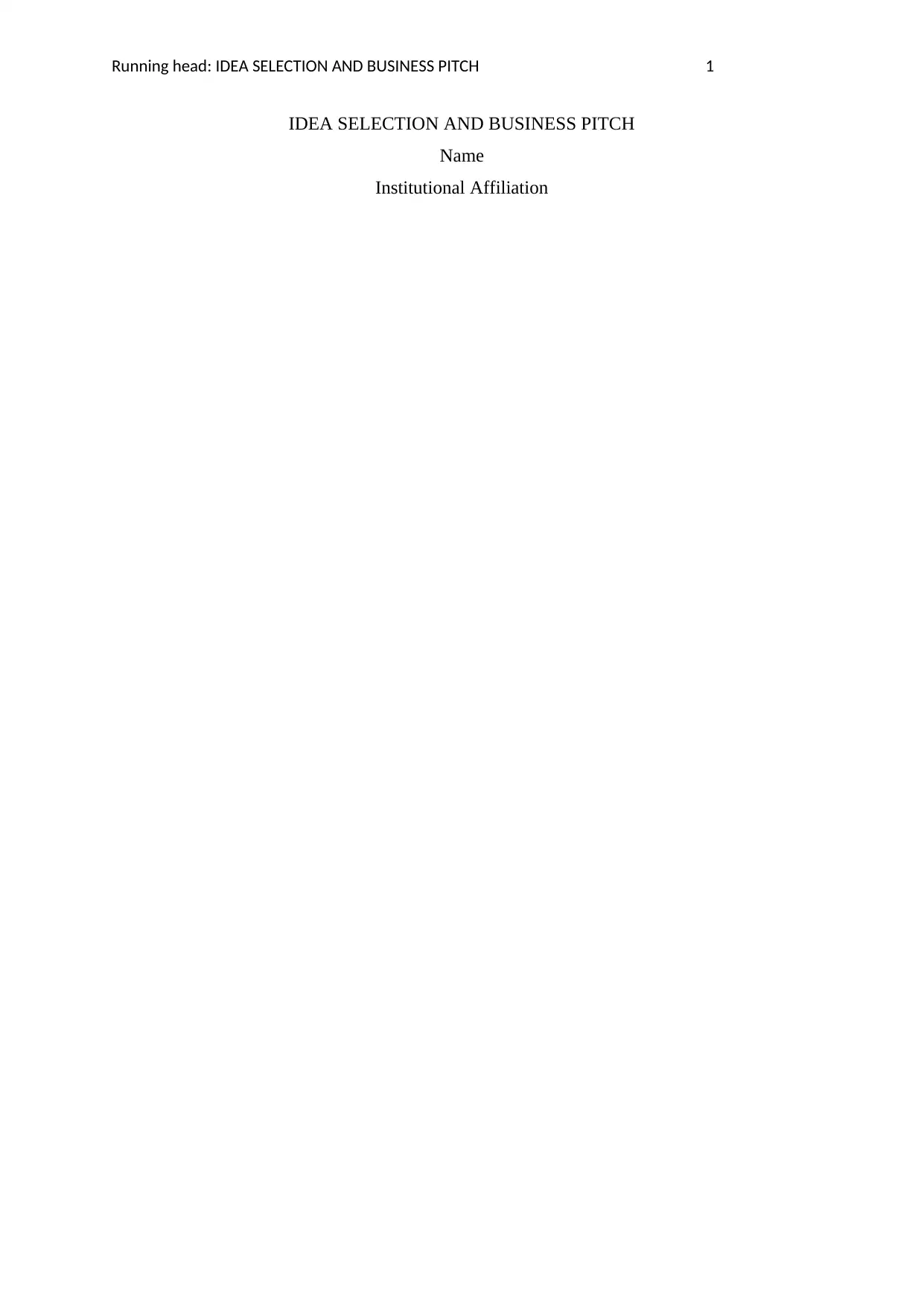
Running head: IDEA SELECTION AND BUSINESS PITCH 1
IDEA SELECTION AND BUSINESS PITCH
Name
Institutional Affiliation
IDEA SELECTION AND BUSINESS PITCH
Name
Institutional Affiliation
Secure Best Marks with AI Grader
Need help grading? Try our AI Grader for instant feedback on your assignments.
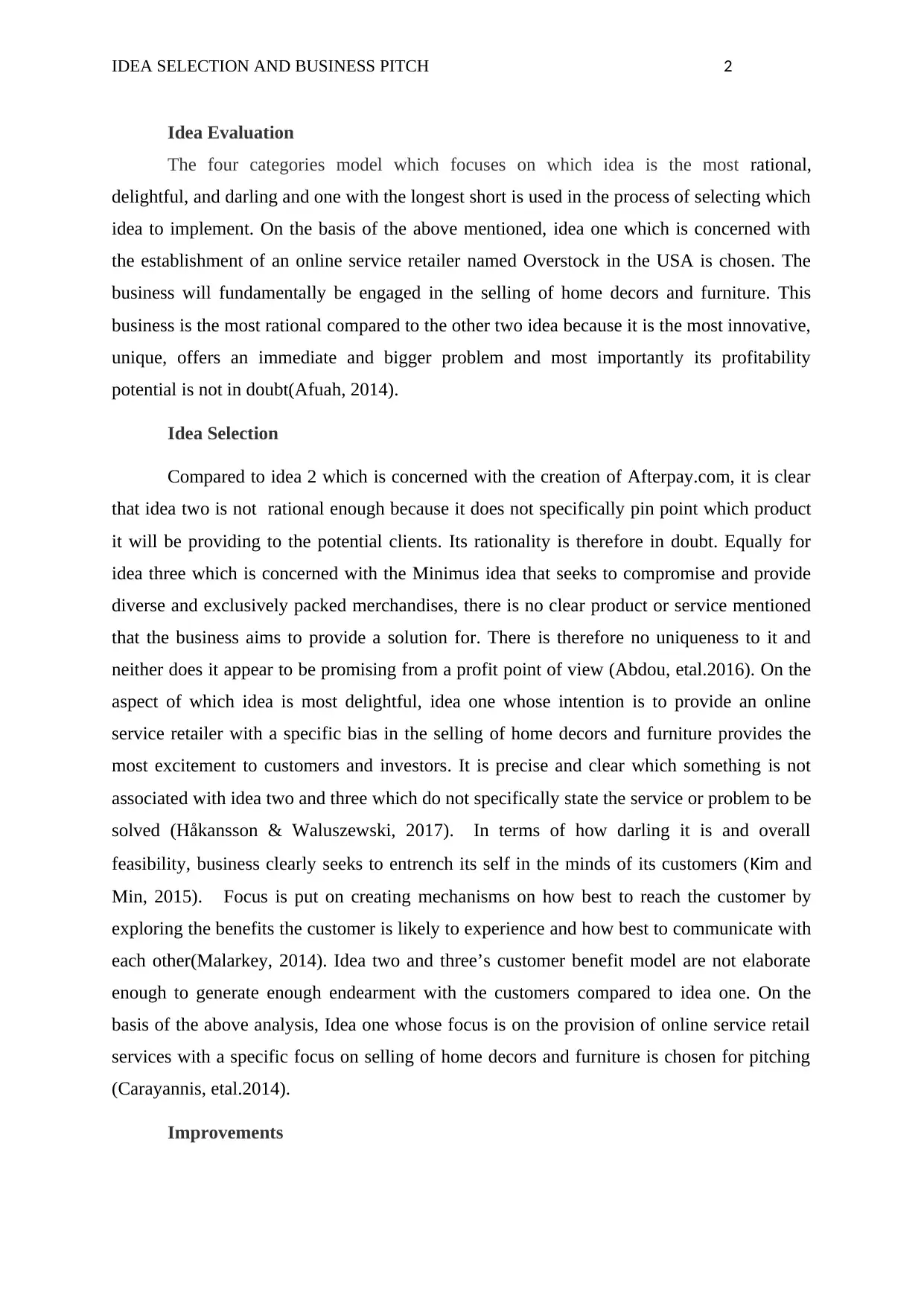
IDEA SELECTION AND BUSINESS PITCH 2
Idea Evaluation
The four categories model which focuses on which idea is the most rational,
delightful, and darling and one with the longest short is used in the process of selecting which
idea to implement. On the basis of the above mentioned, idea one which is concerned with
the establishment of an online service retailer named Overstock in the USA is chosen. The
business will fundamentally be engaged in the selling of home decors and furniture. This
business is the most rational compared to the other two idea because it is the most innovative,
unique, offers an immediate and bigger problem and most importantly its profitability
potential is not in doubt(Afuah, 2014).
Idea Selection
Compared to idea 2 which is concerned with the creation of Afterpay.com, it is clear
that idea two is not rational enough because it does not specifically pin point which product
it will be providing to the potential clients. Its rationality is therefore in doubt. Equally for
idea three which is concerned with the Minimus idea that seeks to compromise and provide
diverse and exclusively packed merchandises, there is no clear product or service mentioned
that the business aims to provide a solution for. There is therefore no uniqueness to it and
neither does it appear to be promising from a profit point of view (Abdou, etal.2016). On the
aspect of which idea is most delightful, idea one whose intention is to provide an online
service retailer with a specific bias in the selling of home decors and furniture provides the
most excitement to customers and investors. It is precise and clear which something is not
associated with idea two and three which do not specifically state the service or problem to be
solved (Håkansson & Waluszewski, 2017). In terms of how darling it is and overall
feasibility, business clearly seeks to entrench its self in the minds of its customers (Kim and
Min, 2015). Focus is put on creating mechanisms on how best to reach the customer by
exploring the benefits the customer is likely to experience and how best to communicate with
each other(Malarkey, 2014). Idea two and three’s customer benefit model are not elaborate
enough to generate enough endearment with the customers compared to idea one. On the
basis of the above analysis, Idea one whose focus is on the provision of online service retail
services with a specific focus on selling of home decors and furniture is chosen for pitching
(Carayannis, etal.2014).
Improvements
Idea Evaluation
The four categories model which focuses on which idea is the most rational,
delightful, and darling and one with the longest short is used in the process of selecting which
idea to implement. On the basis of the above mentioned, idea one which is concerned with
the establishment of an online service retailer named Overstock in the USA is chosen. The
business will fundamentally be engaged in the selling of home decors and furniture. This
business is the most rational compared to the other two idea because it is the most innovative,
unique, offers an immediate and bigger problem and most importantly its profitability
potential is not in doubt(Afuah, 2014).
Idea Selection
Compared to idea 2 which is concerned with the creation of Afterpay.com, it is clear
that idea two is not rational enough because it does not specifically pin point which product
it will be providing to the potential clients. Its rationality is therefore in doubt. Equally for
idea three which is concerned with the Minimus idea that seeks to compromise and provide
diverse and exclusively packed merchandises, there is no clear product or service mentioned
that the business aims to provide a solution for. There is therefore no uniqueness to it and
neither does it appear to be promising from a profit point of view (Abdou, etal.2016). On the
aspect of which idea is most delightful, idea one whose intention is to provide an online
service retailer with a specific bias in the selling of home decors and furniture provides the
most excitement to customers and investors. It is precise and clear which something is not
associated with idea two and three which do not specifically state the service or problem to be
solved (Håkansson & Waluszewski, 2017). In terms of how darling it is and overall
feasibility, business clearly seeks to entrench its self in the minds of its customers (Kim and
Min, 2015). Focus is put on creating mechanisms on how best to reach the customer by
exploring the benefits the customer is likely to experience and how best to communicate with
each other(Malarkey, 2014). Idea two and three’s customer benefit model are not elaborate
enough to generate enough endearment with the customers compared to idea one. On the
basis of the above analysis, Idea one whose focus is on the provision of online service retail
services with a specific focus on selling of home decors and furniture is chosen for pitching
(Carayannis, etal.2014).
Improvements
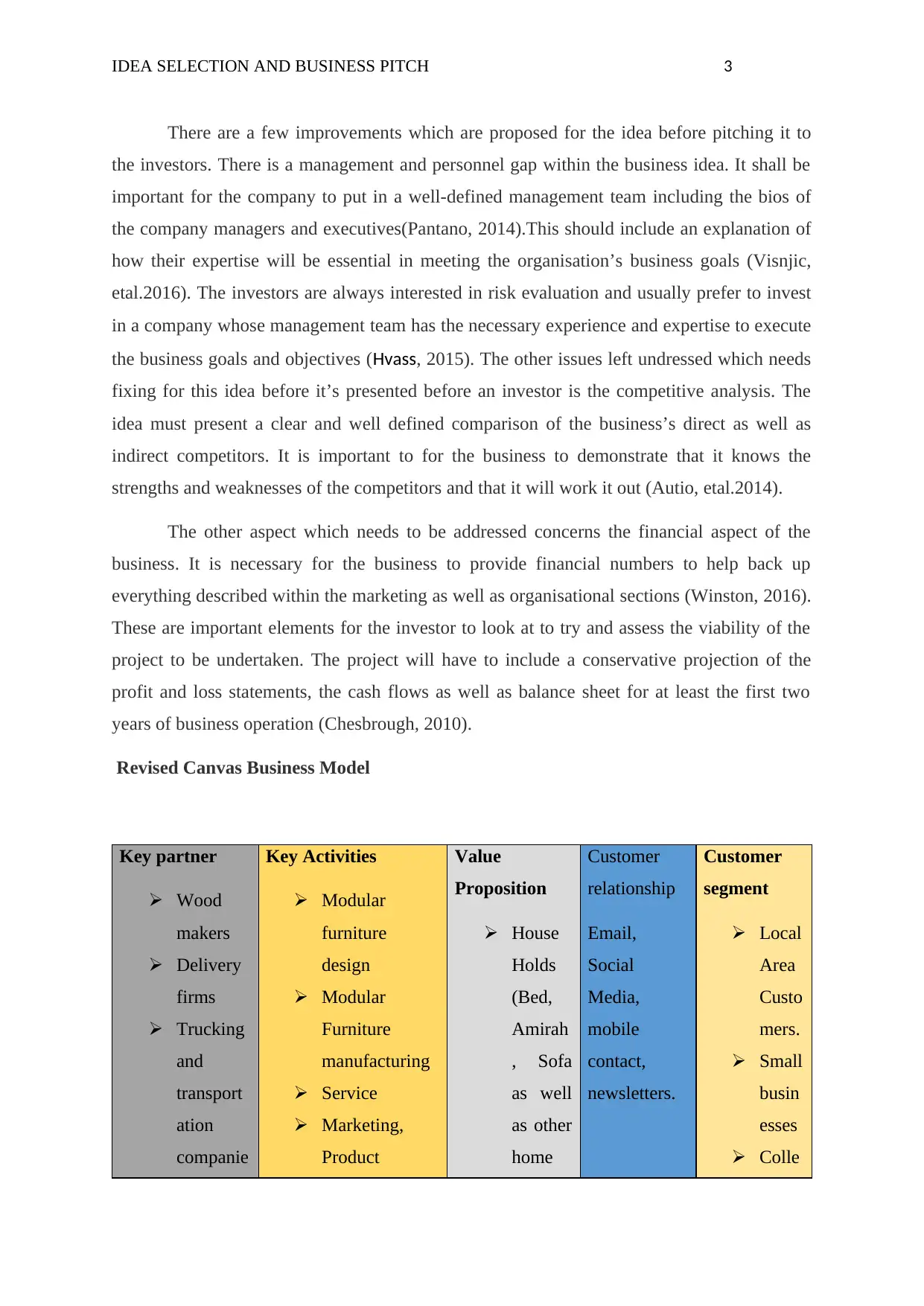
IDEA SELECTION AND BUSINESS PITCH 3
There are a few improvements which are proposed for the idea before pitching it to
the investors. There is a management and personnel gap within the business idea. It shall be
important for the company to put in a well-defined management team including the bios of
the company managers and executives(Pantano, 2014).This should include an explanation of
how their expertise will be essential in meeting the organisation’s business goals (Visnjic,
etal.2016). The investors are always interested in risk evaluation and usually prefer to invest
in a company whose management team has the necessary experience and expertise to execute
the business goals and objectives (Hvass, 2015). The other issues left undressed which needs
fixing for this idea before it’s presented before an investor is the competitive analysis. The
idea must present a clear and well defined comparison of the business’s direct as well as
indirect competitors. It is important to for the business to demonstrate that it knows the
strengths and weaknesses of the competitors and that it will work it out (Autio, etal.2014).
The other aspect which needs to be addressed concerns the financial aspect of the
business. It is necessary for the business to provide financial numbers to help back up
everything described within the marketing as well as organisational sections (Winston, 2016).
These are important elements for the investor to look at to try and assess the viability of the
project to be undertaken. The project will have to include a conservative projection of the
profit and loss statements, the cash flows as well as balance sheet for at least the first two
years of business operation (Chesbrough, 2010).
Revised Canvas Business Model
Key partner
Wood
makers
Delivery
firms
Trucking
and
transport
ation
companie
Key Activities
Modular
furniture
design
Modular
Furniture
manufacturing
Service
Marketing,
Product
Value
Proposition
House
Holds
(Bed,
Amirah
, Sofa
as well
as other
home
Customer
relationship
Email,
Social
Media,
mobile
contact,
newsletters.
Customer
segment
Local
Area
Custo
mers.
Small
busin
esses
Colle
There are a few improvements which are proposed for the idea before pitching it to
the investors. There is a management and personnel gap within the business idea. It shall be
important for the company to put in a well-defined management team including the bios of
the company managers and executives(Pantano, 2014).This should include an explanation of
how their expertise will be essential in meeting the organisation’s business goals (Visnjic,
etal.2016). The investors are always interested in risk evaluation and usually prefer to invest
in a company whose management team has the necessary experience and expertise to execute
the business goals and objectives (Hvass, 2015). The other issues left undressed which needs
fixing for this idea before it’s presented before an investor is the competitive analysis. The
idea must present a clear and well defined comparison of the business’s direct as well as
indirect competitors. It is important to for the business to demonstrate that it knows the
strengths and weaknesses of the competitors and that it will work it out (Autio, etal.2014).
The other aspect which needs to be addressed concerns the financial aspect of the
business. It is necessary for the business to provide financial numbers to help back up
everything described within the marketing as well as organisational sections (Winston, 2016).
These are important elements for the investor to look at to try and assess the viability of the
project to be undertaken. The project will have to include a conservative projection of the
profit and loss statements, the cash flows as well as balance sheet for at least the first two
years of business operation (Chesbrough, 2010).
Revised Canvas Business Model
Key partner
Wood
makers
Delivery
firms
Trucking
and
transport
ation
companie
Key Activities
Modular
furniture
design
Modular
Furniture
manufacturing
Service
Marketing,
Product
Value
Proposition
House
Holds
(Bed,
Amirah
, Sofa
as well
as other
home
Customer
relationship
Email,
Social
Media,
mobile
contact,
newsletters.
Customer
segment
Local
Area
Custo
mers.
Small
busin
esses
Colle
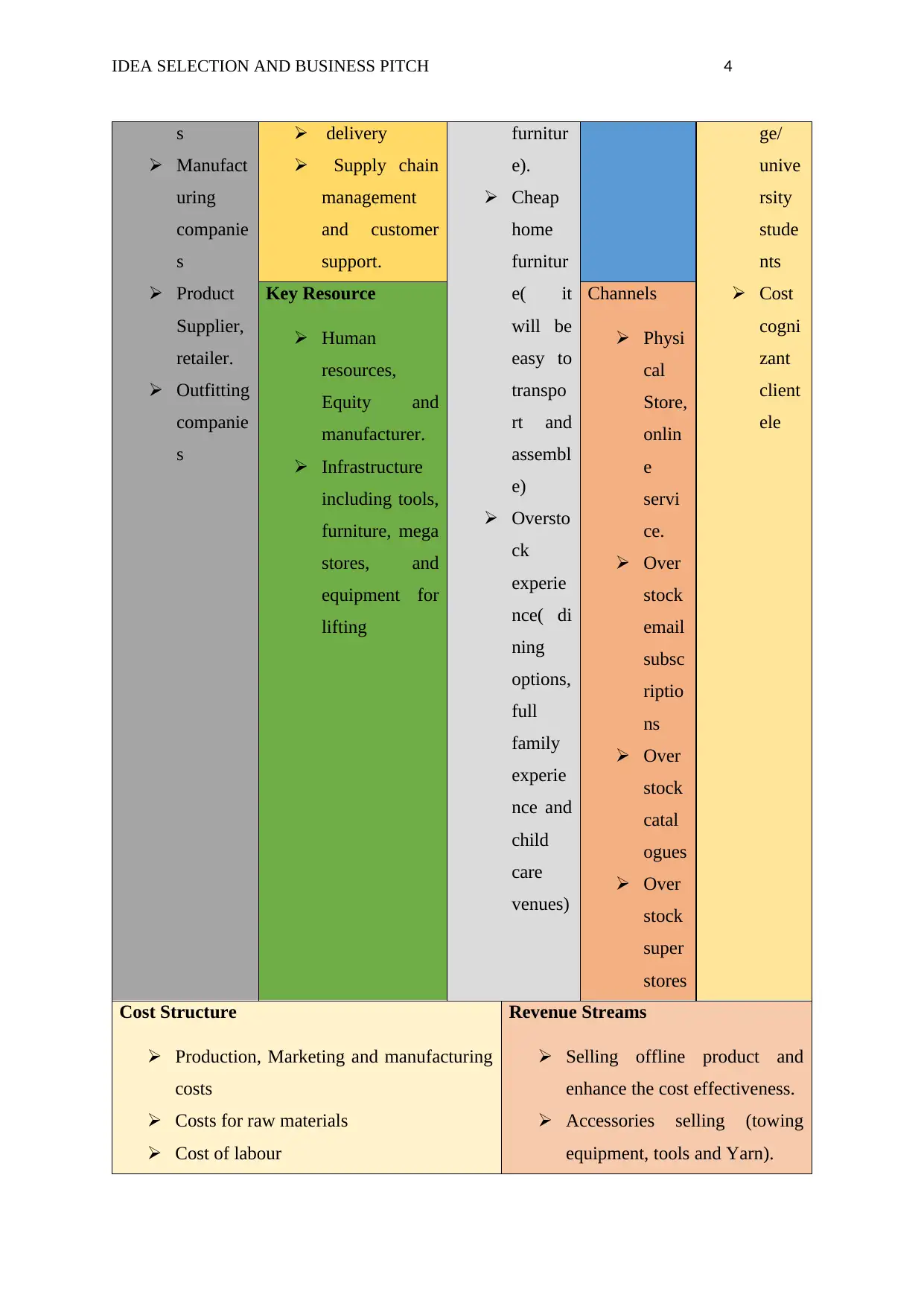
IDEA SELECTION AND BUSINESS PITCH 4
s
Manufact
uring
companie
s
Product
Supplier,
retailer.
Outfitting
companie
s
delivery
Supply chain
management
and customer
support.
furnitur
e).
Cheap
home
furnitur
e( it
will be
easy to
transpo
rt and
assembl
e)
Oversto
ck
experie
nce( di
ning
options,
full
family
experie
nce and
child
care
venues)
ge/
unive
rsity
stude
nts
Cost
cogni
zant
client
ele
Key Resource
Human
resources,
Equity and
manufacturer.
Infrastructure
including tools,
furniture, mega
stores, and
equipment for
lifting
Channels
Physi
cal
Store,
onlin
e
servi
ce.
Over
stock
email
subsc
riptio
ns
Over
stock
catal
ogues
Over
stock
super
stores
Cost Structure
Production, Marketing and manufacturing
costs
Costs for raw materials
Cost of labour
Revenue Streams
Selling offline product and
enhance the cost effectiveness.
Accessories selling (towing
equipment, tools and Yarn).
s
Manufact
uring
companie
s
Product
Supplier,
retailer.
Outfitting
companie
s
delivery
Supply chain
management
and customer
support.
furnitur
e).
Cheap
home
furnitur
e( it
will be
easy to
transpo
rt and
assembl
e)
Oversto
ck
experie
nce( di
ning
options,
full
family
experie
nce and
child
care
venues)
ge/
unive
rsity
stude
nts
Cost
cogni
zant
client
ele
Key Resource
Human
resources,
Equity and
manufacturer.
Infrastructure
including tools,
furniture, mega
stores, and
equipment for
lifting
Channels
Physi
cal
Store,
onlin
e
servi
ce.
Over
stock
subsc
riptio
ns
Over
stock
catal
ogues
Over
stock
super
stores
Cost Structure
Production, Marketing and manufacturing
costs
Costs for raw materials
Cost of labour
Revenue Streams
Selling offline product and
enhance the cost effectiveness.
Accessories selling (towing
equipment, tools and Yarn).
Secure Best Marks with AI Grader
Need help grading? Try our AI Grader for instant feedback on your assignments.
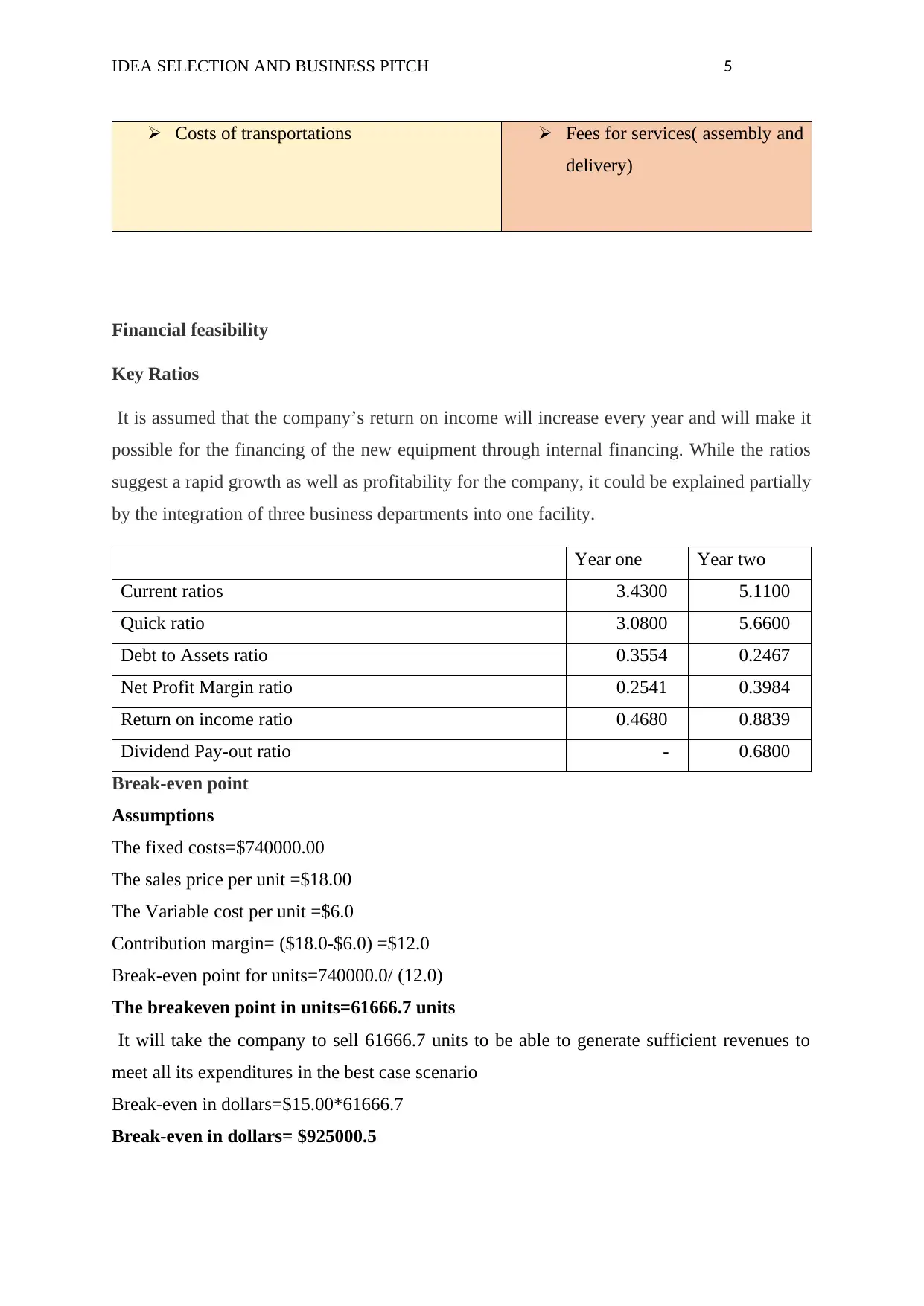
IDEA SELECTION AND BUSINESS PITCH 5
Costs of transportations Fees for services( assembly and
delivery)
Financial feasibility
Key Ratios
It is assumed that the company’s return on income will increase every year and will make it
possible for the financing of the new equipment through internal financing. While the ratios
suggest a rapid growth as well as profitability for the company, it could be explained partially
by the integration of three business departments into one facility.
Year one Year two
Current ratios 3.4300 5.1100
Quick ratio 3.0800 5.6600
Debt to Assets ratio 0.3554 0.2467
Net Profit Margin ratio 0.2541 0.3984
Return on income ratio 0.4680 0.8839
Dividend Pay-out ratio - 0.6800
Break-even point
Assumptions
The fixed costs=$740000.00
The sales price per unit =$18.00
The Variable cost per unit =$6.0
Contribution margin= ($18.0-$6.0) =$12.0
Break-even point for units=740000.0/ (12.0)
The breakeven point in units=61666.7 units
It will take the company to sell 61666.7 units to be able to generate sufficient revenues to
meet all its expenditures in the best case scenario
Break-even in dollars=$15.00*61666.7
Break-even in dollars= $925000.5
Costs of transportations Fees for services( assembly and
delivery)
Financial feasibility
Key Ratios
It is assumed that the company’s return on income will increase every year and will make it
possible for the financing of the new equipment through internal financing. While the ratios
suggest a rapid growth as well as profitability for the company, it could be explained partially
by the integration of three business departments into one facility.
Year one Year two
Current ratios 3.4300 5.1100
Quick ratio 3.0800 5.6600
Debt to Assets ratio 0.3554 0.2467
Net Profit Margin ratio 0.2541 0.3984
Return on income ratio 0.4680 0.8839
Dividend Pay-out ratio - 0.6800
Break-even point
Assumptions
The fixed costs=$740000.00
The sales price per unit =$18.00
The Variable cost per unit =$6.0
Contribution margin= ($18.0-$6.0) =$12.0
Break-even point for units=740000.0/ (12.0)
The breakeven point in units=61666.7 units
It will take the company to sell 61666.7 units to be able to generate sufficient revenues to
meet all its expenditures in the best case scenario
Break-even in dollars=$15.00*61666.7
Break-even in dollars= $925000.5
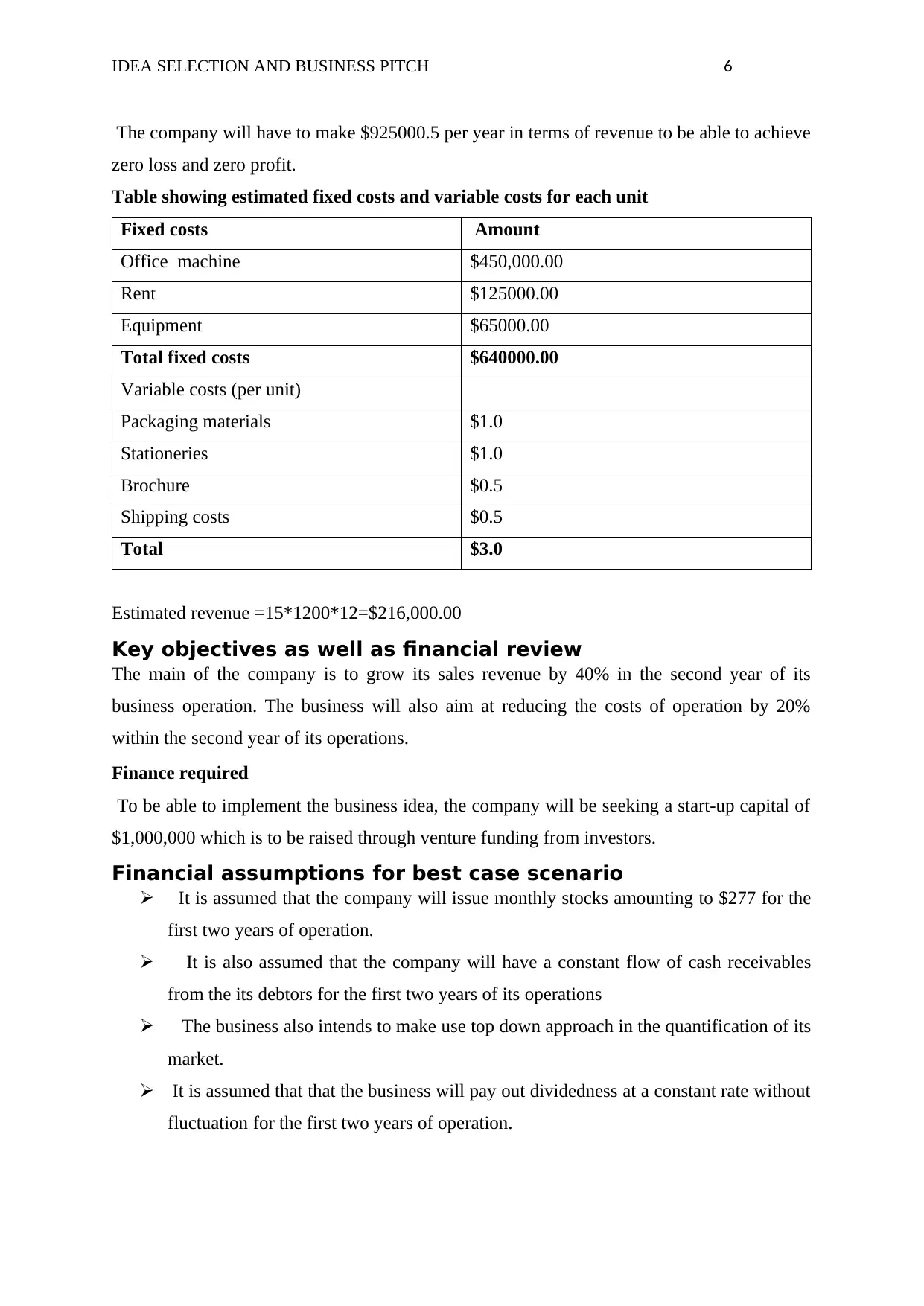
IDEA SELECTION AND BUSINESS PITCH 6
The company will have to make $925000.5 per year in terms of revenue to be able to achieve
zero loss and zero profit.
Table showing estimated fixed costs and variable costs for each unit
Fixed costs Amount
Office machine $450,000.00
Rent $125000.00
Equipment $65000.00
Total fixed costs $640000.00
Variable costs (per unit)
Packaging materials $1.0
Stationeries $1.0
Brochure $0.5
Shipping costs $0.5
Total $3.0
Estimated revenue =15*1200*12=$216,000.00
Key objectives as well as financial review
The main of the company is to grow its sales revenue by 40% in the second year of its
business operation. The business will also aim at reducing the costs of operation by 20%
within the second year of its operations.
Finance required
To be able to implement the business idea, the company will be seeking a start-up capital of
$1,000,000 which is to be raised through venture funding from investors.
Financial assumptions for best case scenario
It is assumed that the company will issue monthly stocks amounting to $277 for the
first two years of operation.
It is also assumed that the company will have a constant flow of cash receivables
from the its debtors for the first two years of its operations
The business also intends to make use top down approach in the quantification of its
market.
It is assumed that that the business will pay out dividedness at a constant rate without
fluctuation for the first two years of operation.
The company will have to make $925000.5 per year in terms of revenue to be able to achieve
zero loss and zero profit.
Table showing estimated fixed costs and variable costs for each unit
Fixed costs Amount
Office machine $450,000.00
Rent $125000.00
Equipment $65000.00
Total fixed costs $640000.00
Variable costs (per unit)
Packaging materials $1.0
Stationeries $1.0
Brochure $0.5
Shipping costs $0.5
Total $3.0
Estimated revenue =15*1200*12=$216,000.00
Key objectives as well as financial review
The main of the company is to grow its sales revenue by 40% in the second year of its
business operation. The business will also aim at reducing the costs of operation by 20%
within the second year of its operations.
Finance required
To be able to implement the business idea, the company will be seeking a start-up capital of
$1,000,000 which is to be raised through venture funding from investors.
Financial assumptions for best case scenario
It is assumed that the company will issue monthly stocks amounting to $277 for the
first two years of operation.
It is also assumed that the company will have a constant flow of cash receivables
from the its debtors for the first two years of its operations
The business also intends to make use top down approach in the quantification of its
market.
It is assumed that that the business will pay out dividedness at a constant rate without
fluctuation for the first two years of operation.
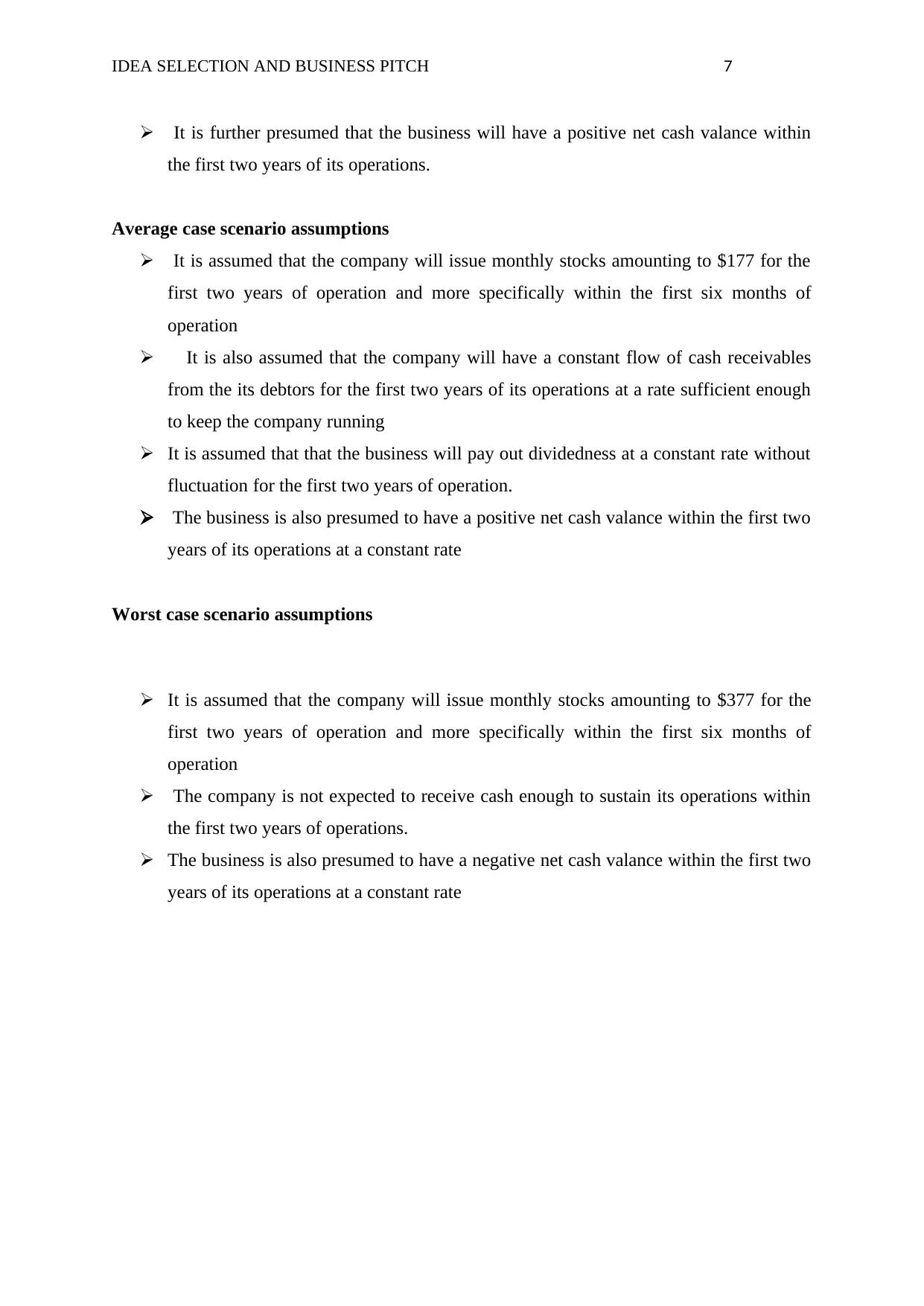
IDEA SELECTION AND BUSINESS PITCH 7
It is further presumed that the business will have a positive net cash valance within
the first two years of its operations.
Average case scenario assumptions
It is assumed that the company will issue monthly stocks amounting to $177 for the
first two years of operation and more specifically within the first six months of
operation
It is also assumed that the company will have a constant flow of cash receivables
from the its debtors for the first two years of its operations at a rate sufficient enough
to keep the company running
It is assumed that that the business will pay out dividedness at a constant rate without
fluctuation for the first two years of operation.
The business is also presumed to have a positive net cash valance within the first two
years of its operations at a constant rate
Worst case scenario assumptions
It is assumed that the company will issue monthly stocks amounting to $377 for the
first two years of operation and more specifically within the first six months of
operation
The company is not expected to receive cash enough to sustain its operations within
the first two years of operations.
The business is also presumed to have a negative net cash valance within the first two
years of its operations at a constant rate
It is further presumed that the business will have a positive net cash valance within
the first two years of its operations.
Average case scenario assumptions
It is assumed that the company will issue monthly stocks amounting to $177 for the
first two years of operation and more specifically within the first six months of
operation
It is also assumed that the company will have a constant flow of cash receivables
from the its debtors for the first two years of its operations at a rate sufficient enough
to keep the company running
It is assumed that that the business will pay out dividedness at a constant rate without
fluctuation for the first two years of operation.
The business is also presumed to have a positive net cash valance within the first two
years of its operations at a constant rate
Worst case scenario assumptions
It is assumed that the company will issue monthly stocks amounting to $377 for the
first two years of operation and more specifically within the first six months of
operation
The company is not expected to receive cash enough to sustain its operations within
the first two years of operations.
The business is also presumed to have a negative net cash valance within the first two
years of its operations at a constant rate
Paraphrase This Document
Need a fresh take? Get an instant paraphrase of this document with our AI Paraphraser
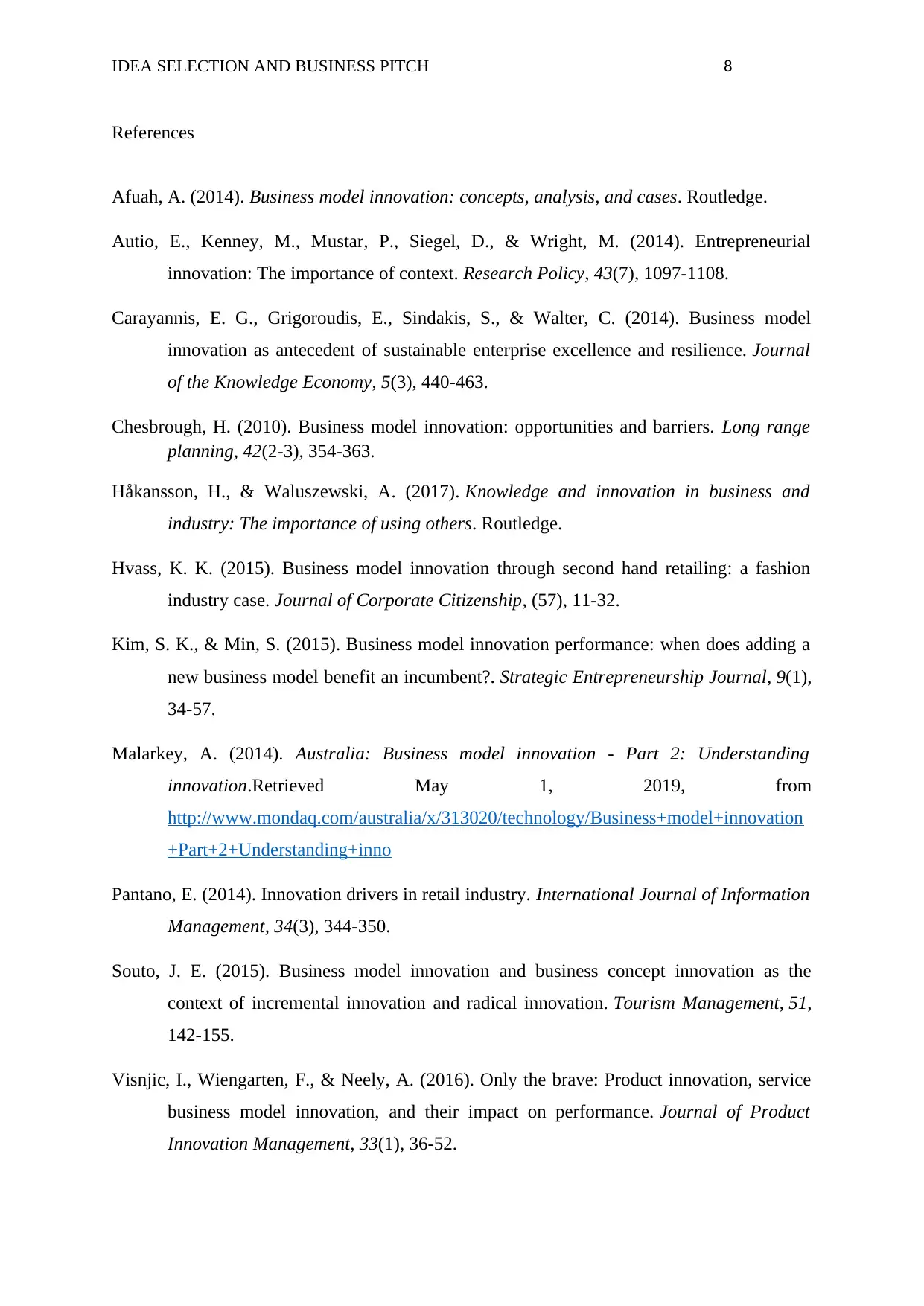
IDEA SELECTION AND BUSINESS PITCH 8
References
Afuah, A. (2014). Business model innovation: concepts, analysis, and cases. Routledge.
Autio, E., Kenney, M., Mustar, P., Siegel, D., & Wright, M. (2014). Entrepreneurial
innovation: The importance of context. Research Policy, 43(7), 1097-1108.
Carayannis, E. G., Grigoroudis, E., Sindakis, S., & Walter, C. (2014). Business model
innovation as antecedent of sustainable enterprise excellence and resilience. Journal
of the Knowledge Economy, 5(3), 440-463.
Chesbrough, H. (2010). Business model innovation: opportunities and barriers. Long range
planning, 42(2-3), 354-363.
Håkansson, H., & Waluszewski, A. (2017). Knowledge and innovation in business and
industry: The importance of using others. Routledge.
Hvass, K. K. (2015). Business model innovation through second hand retailing: a fashion
industry case. Journal of Corporate Citizenship, (57), 11-32.
Kim, S. K., & Min, S. (2015). Business model innovation performance: when does adding a
new business model benefit an incumbent?. Strategic Entrepreneurship Journal, 9(1),
34-57.
Malarkey, A. (2014). Australia: Business model innovation - Part 2: Understanding
innovation.Retrieved May 1, 2019, from
http://www.mondaq.com/australia/x/313020/technology/Business+model+innovation
+Part+2+Understanding+inno
Pantano, E. (2014). Innovation drivers in retail industry. International Journal of Information
Management, 34(3), 344-350.
Souto, J. E. (2015). Business model innovation and business concept innovation as the
context of incremental innovation and radical innovation. Tourism Management, 51,
142-155.
Visnjic, I., Wiengarten, F., & Neely, A. (2016). Only the brave: Product innovation, service
business model innovation, and their impact on performance. Journal of Product
Innovation Management, 33(1), 36-52.
References
Afuah, A. (2014). Business model innovation: concepts, analysis, and cases. Routledge.
Autio, E., Kenney, M., Mustar, P., Siegel, D., & Wright, M. (2014). Entrepreneurial
innovation: The importance of context. Research Policy, 43(7), 1097-1108.
Carayannis, E. G., Grigoroudis, E., Sindakis, S., & Walter, C. (2014). Business model
innovation as antecedent of sustainable enterprise excellence and resilience. Journal
of the Knowledge Economy, 5(3), 440-463.
Chesbrough, H. (2010). Business model innovation: opportunities and barriers. Long range
planning, 42(2-3), 354-363.
Håkansson, H., & Waluszewski, A. (2017). Knowledge and innovation in business and
industry: The importance of using others. Routledge.
Hvass, K. K. (2015). Business model innovation through second hand retailing: a fashion
industry case. Journal of Corporate Citizenship, (57), 11-32.
Kim, S. K., & Min, S. (2015). Business model innovation performance: when does adding a
new business model benefit an incumbent?. Strategic Entrepreneurship Journal, 9(1),
34-57.
Malarkey, A. (2014). Australia: Business model innovation - Part 2: Understanding
innovation.Retrieved May 1, 2019, from
http://www.mondaq.com/australia/x/313020/technology/Business+model+innovation
+Part+2+Understanding+inno
Pantano, E. (2014). Innovation drivers in retail industry. International Journal of Information
Management, 34(3), 344-350.
Souto, J. E. (2015). Business model innovation and business concept innovation as the
context of incremental innovation and radical innovation. Tourism Management, 51,
142-155.
Visnjic, I., Wiengarten, F., & Neely, A. (2016). Only the brave: Product innovation, service
business model innovation, and their impact on performance. Journal of Product
Innovation Management, 33(1), 36-52.
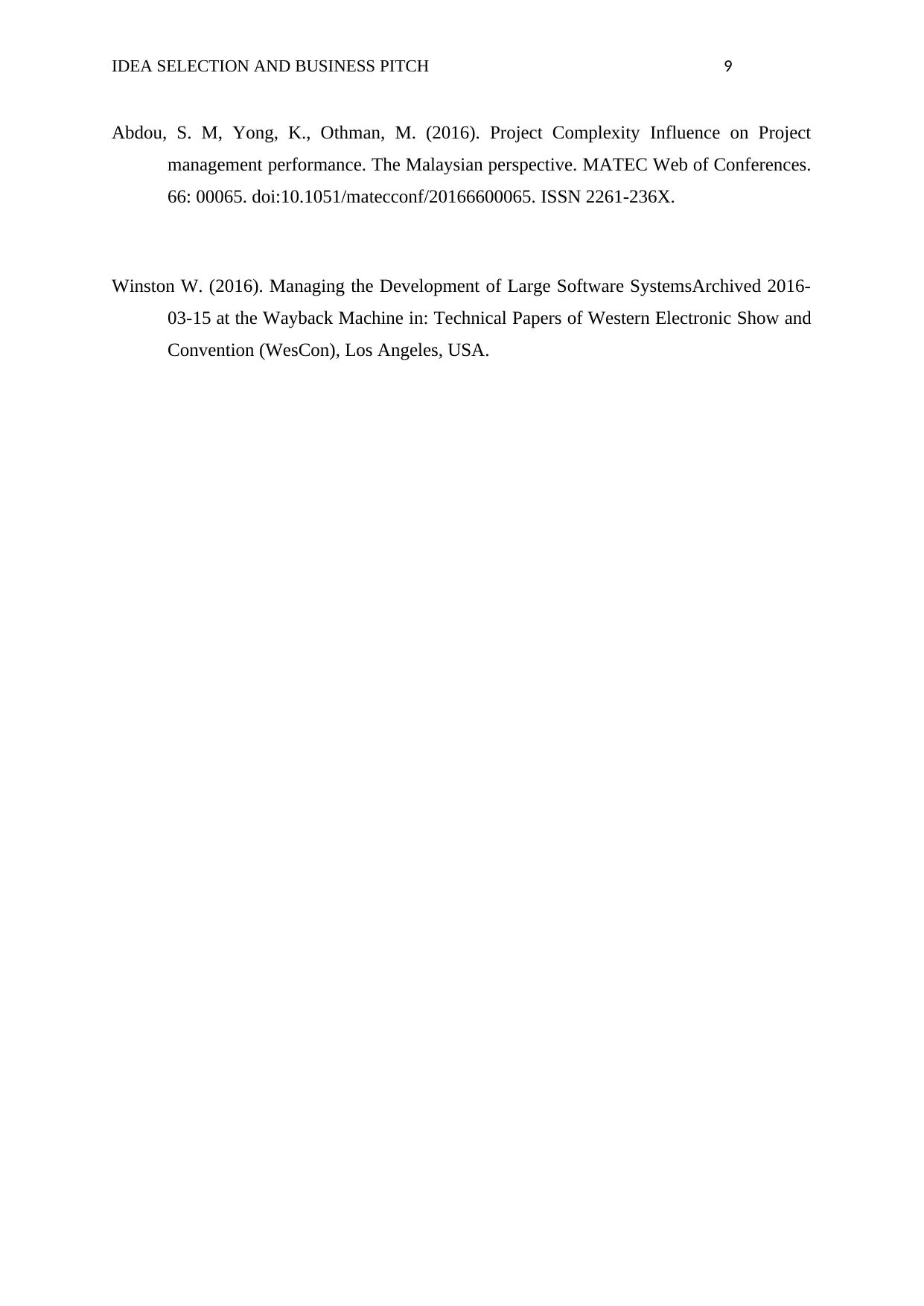
IDEA SELECTION AND BUSINESS PITCH 9
Abdou, S. M, Yong, K., Othman, M. (2016). Project Complexity Influence on Project
management performance. The Malaysian perspective. MATEC Web of Conferences.
66: 00065. doi:10.1051/matecconf/20166600065. ISSN 2261-236X.
Winston W. (2016). Managing the Development of Large Software SystemsArchived 2016-
03-15 at the Wayback Machine in: Technical Papers of Western Electronic Show and
Convention (WesCon), Los Angeles, USA.
Abdou, S. M, Yong, K., Othman, M. (2016). Project Complexity Influence on Project
management performance. The Malaysian perspective. MATEC Web of Conferences.
66: 00065. doi:10.1051/matecconf/20166600065. ISSN 2261-236X.
Winston W. (2016). Managing the Development of Large Software SystemsArchived 2016-
03-15 at the Wayback Machine in: Technical Papers of Western Electronic Show and
Convention (WesCon), Los Angeles, USA.
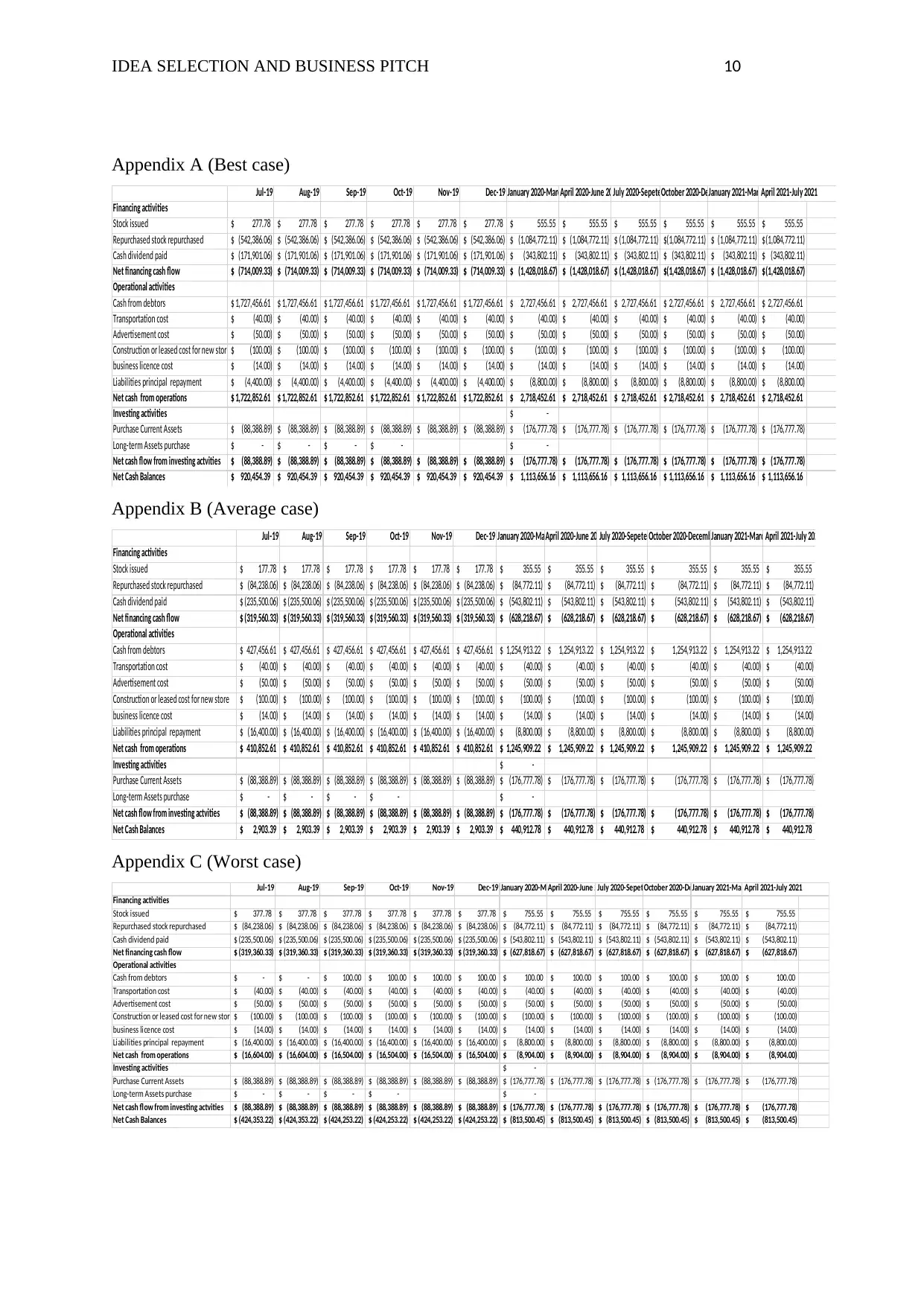
IDEA SELECTION AND BUSINESS PITCH 10
Appendix A (Best case)
Jul-19 Aug-19 Sep-19 Oct-19 Nov-19 Dec-19 January 2020-March 2020April 2020-June 2020July 2020-Sepetember 2020October 2020-December 2020January 2021-March 2021April 2021-July 2021
Financing activities
Stock issued 277.78$ 277.78$ 277.78$ 277.78$ 277.78$ 277.78$ 555.55$ 555.55$ 555.55$ 555.55$ 555.55$ 555.55$
Repurchased stock repurchased (542,386.06)$ (542,386.06)$ (542,386.06)$ (542,386.06)$ (542,386.06)$ (542,386.06)$ (1,084,772.11)$ (1,084,772.11)$ (1,084,772.11)$ (1,084,772.11)$ (1,084,772.11)$ (1,084,772.11)$
Cash dividend paid (171,901.06)$ (171,901.06)$ (171,901.06)$ (171,901.06)$ (171,901.06)$ (171,901.06)$ (343,802.11)$ (343,802.11)$ (343,802.11)$ (343,802.11)$ (343,802.11)$ (343,802.11)$
Net financing cash flow (714,009.33)$ (714,009.33)$ (714,009.33)$ (714,009.33)$ (714,009.33)$ (714,009.33)$ (1,428,018.67)$ (1,428,018.67)$ (1,428,018.67)$ (1,428,018.67)$ (1,428,018.67)$ (1,428,018.67)$
Operational activities
Cash from debtors 1,727,456.61$ 1,727,456.61$ 1,727,456.61$ 1,727,456.61$ 1,727,456.61$ 1,727,456.61$ 2,727,456.61$ 2,727,456.61$ 2,727,456.61$ 2,727,456.61$ 2,727,456.61$ 2,727,456.61$
Transportation cost (40.00)$ (40.00)$ (40.00)$ (40.00)$ (40.00)$ (40.00)$ (40.00)$ (40.00)$ (40.00)$ (40.00)$ (40.00)$ (40.00)$
Advertisement cost (50.00)$ (50.00)$ (50.00)$ (50.00)$ (50.00)$ (50.00)$ (50.00)$ (50.00)$ (50.00)$ (50.00)$ (50.00)$ (50.00)$
Construction or leased cost for new store (100.00)$ (100.00)$ (100.00)$ (100.00)$ (100.00)$ (100.00)$ (100.00)$ (100.00)$ (100.00)$ (100.00)$ (100.00)$ (100.00)$
business licence cost (14.00)$ (14.00)$ (14.00)$ (14.00)$ (14.00)$ (14.00)$ (14.00)$ (14.00)$ (14.00)$ (14.00)$ (14.00)$ (14.00)$
Liabilities principal repayment (4,400.00)$ (4,400.00)$ (4,400.00)$ (4,400.00)$ (4,400.00)$ (4,400.00)$ (8,800.00)$ (8,800.00)$ (8,800.00)$ (8,800.00)$ (8,800.00)$ (8,800.00)$
Net cash from operations 1,722,852.61$ 1,722,852.61$ 1,722,852.61$ 1,722,852.61$ 1,722,852.61$ 1,722,852.61$ 2,718,452.61$ 2,718,452.61$ 2,718,452.61$ 2,718,452.61$ 2,718,452.61$ 2,718,452.61$
Investing activities -$
Purchase Current Assets (88,388.89)$ (88,388.89)$ (88,388.89)$ (88,388.89)$ (88,388.89)$ (88,388.89)$ (176,777.78)$ (176,777.78)$ (176,777.78)$ (176,777.78)$ (176,777.78)$ (176,777.78)$
Long-term Assets purchase -$ -$ -$ -$ -$
Net cash flow from investing actvities (88,388.89)$ (88,388.89)$ (88,388.89)$ (88,388.89)$ (88,388.89)$ (88,388.89)$ (176,777.78)$ (176,777.78)$ (176,777.78)$ (176,777.78)$ (176,777.78)$ (176,777.78)$
Net Cash Balances 920,454.39$ 920,454.39$ 920,454.39$ 920,454.39$ 920,454.39$ 920,454.39$ 1,113,656.16$ 1,113,656.16$ 1,113,656.16$ 1,113,656.16$ 1,113,656.16$ 1,113,656.16$
Appendix B (Average case)
Jul-19 Aug-19 Sep-19 Oct-19 Nov-19 Dec-19 January 2020-March 2020April 2020-June 2020July 2020-Sepetember 2020October 2020-December 2020January 2021-March 2021April 2021-July 2021
Financing activities
Stock issued 177.78$ 177.78$ 177.78$ 177.78$ 177.78$ 177.78$ 355.55$ 355.55$ 355.55$ 355.55$ 355.55$ 355.55$
Repurchased stock repurchased (84,238.06)$ (84,238.06)$ (84,238.06)$ (84,238.06)$ (84,238.06)$ (84,238.06)$ (84,772.11)$ (84,772.11)$ (84,772.11)$ (84,772.11)$ (84,772.11)$ (84,772.11)$
Cash dividend paid (235,500.06)$ (235,500.06)$ (235,500.06)$ (235,500.06)$ (235,500.06)$ (235,500.06)$ (543,802.11)$ (543,802.11)$ (543,802.11)$ (543,802.11)$ (543,802.11)$ (543,802.11)$
Net financing cash flow (319,560.33)$ (319,560.33)$ (319,560.33)$ (319,560.33)$ (319,560.33)$ (319,560.33)$ (628,218.67)$ (628,218.67)$ (628,218.67)$ (628,218.67)$ (628,218.67)$ (628,218.67)$
Operational activities
Cash from debtors 427,456.61$ 427,456.61$ 427,456.61$ 427,456.61$ 427,456.61$ 427,456.61$ 1,254,913.22$ 1,254,913.22$ 1,254,913.22$ 1,254,913.22$ 1,254,913.22$ 1,254,913.22$
Transportation cost (40.00)$ (40.00)$ (40.00)$ (40.00)$ (40.00)$ (40.00)$ (40.00)$ (40.00)$ (40.00)$ (40.00)$ (40.00)$ (40.00)$
Advertisement cost (50.00)$ (50.00)$ (50.00)$ (50.00)$ (50.00)$ (50.00)$ (50.00)$ (50.00)$ (50.00)$ (50.00)$ (50.00)$ (50.00)$
Construction or leased cost for new store (100.00)$ (100.00)$ (100.00)$ (100.00)$ (100.00)$ (100.00)$ (100.00)$ (100.00)$ (100.00)$ (100.00)$ (100.00)$ (100.00)$
business licence cost (14.00)$ (14.00)$ (14.00)$ (14.00)$ (14.00)$ (14.00)$ (14.00)$ (14.00)$ (14.00)$ (14.00)$ (14.00)$ (14.00)$
Liabilities principal repayment (16,400.00)$ (16,400.00)$ (16,400.00)$ (16,400.00)$ (16,400.00)$ (16,400.00)$ (8,800.00)$ (8,800.00)$ (8,800.00)$ (8,800.00)$ (8,800.00)$ (8,800.00)$
Net cash from operations 410,852.61$ 410,852.61$ 410,852.61$ 410,852.61$ 410,852.61$ 410,852.61$ 1,245,909.22$ 1,245,909.22$ 1,245,909.22$ 1,245,909.22$ 1,245,909.22$ 1,245,909.22$
Investing activities -$
Purchase Current Assets (88,388.89)$ (88,388.89)$ (88,388.89)$ (88,388.89)$ (88,388.89)$ (88,388.89)$ (176,777.78)$ (176,777.78)$ (176,777.78)$ (176,777.78)$ (176,777.78)$ (176,777.78)$
Long-term Assets purchase -$ -$ -$ -$ -$
Net cash flow from investing actvities (88,388.89)$ (88,388.89)$ (88,388.89)$ (88,388.89)$ (88,388.89)$ (88,388.89)$ (176,777.78)$ (176,777.78)$ (176,777.78)$ (176,777.78)$ (176,777.78)$ (176,777.78)$
Net Cash Balances 2,903.39$ 2,903.39$ 2,903.39$ 2,903.39$ 2,903.39$ 2,903.39$ 440,912.78$ 440,912.78$ 440,912.78$ 440,912.78$ 440,912.78$ 440,912.78$
Appendix C (Worst case)
Jul-19 Aug-19 Sep-19 Oct-19 Nov-19 Dec-19 January 2020-March 2020April 2020-June 2020July 2020-Sepetember 2020October 2020-December 2020January 2021-March 2021April 2021-July 2021
Financing activities
Stock issued 377.78$ 377.78$ 377.78$ 377.78$ 377.78$ 377.78$ 755.55$ 755.55$ 755.55$ 755.55$ 755.55$ 755.55$
Repurchased stock repurchased (84,238.06)$ (84,238.06)$ (84,238.06)$ (84,238.06)$ (84,238.06)$ (84,238.06)$ (84,772.11)$ (84,772.11)$ (84,772.11)$ (84,772.11)$ (84,772.11)$ (84,772.11)$
Cash dividend paid (235,500.06)$ (235,500.06)$ (235,500.06)$ (235,500.06)$ (235,500.06)$ (235,500.06)$ (543,802.11)$ (543,802.11)$ (543,802.11)$ (543,802.11)$ (543,802.11)$ (543,802.11)$
Net financing cash flow (319,360.33)$ (319,360.33)$ (319,360.33)$ (319,360.33)$ (319,360.33)$ (319,360.33)$ (627,818.67)$ (627,818.67)$ (627,818.67)$ (627,818.67)$ (627,818.67)$ (627,818.67)$
Operational activities
Cash from debtors -$ -$ 100.00$ 100.00$ 100.00$ 100.00$ 100.00$ 100.00$ 100.00$ 100.00$ 100.00$ 100.00$
Transportation cost (40.00)$ (40.00)$ (40.00)$ (40.00)$ (40.00)$ (40.00)$ (40.00)$ (40.00)$ (40.00)$ (40.00)$ (40.00)$ (40.00)$
Advertisement cost (50.00)$ (50.00)$ (50.00)$ (50.00)$ (50.00)$ (50.00)$ (50.00)$ (50.00)$ (50.00)$ (50.00)$ (50.00)$ (50.00)$
Construction or leased cost for new store (100.00)$ (100.00)$ (100.00)$ (100.00)$ (100.00)$ (100.00)$ (100.00)$ (100.00)$ (100.00)$ (100.00)$ (100.00)$ (100.00)$
business licence cost (14.00)$ (14.00)$ (14.00)$ (14.00)$ (14.00)$ (14.00)$ (14.00)$ (14.00)$ (14.00)$ (14.00)$ (14.00)$ (14.00)$
Liabilities principal repayment (16,400.00)$ (16,400.00)$ (16,400.00)$ (16,400.00)$ (16,400.00)$ (16,400.00)$ (8,800.00)$ (8,800.00)$ (8,800.00)$ (8,800.00)$ (8,800.00)$ (8,800.00)$
Net cash from operations (16,604.00)$ (16,604.00)$ (16,504.00)$ (16,504.00)$ (16,504.00)$ (16,504.00)$ (8,904.00)$ (8,904.00)$ (8,904.00)$ (8,904.00)$ (8,904.00)$ (8,904.00)$
Investing activities -$
Purchase Current Assets (88,388.89)$ (88,388.89)$ (88,388.89)$ (88,388.89)$ (88,388.89)$ (88,388.89)$ (176,777.78)$ (176,777.78)$ (176,777.78)$ (176,777.78)$ (176,777.78)$ (176,777.78)$
Long-term Assets purchase -$ -$ -$ -$ -$
Net cash flow from investing actvities (88,388.89)$ (88,388.89)$ (88,388.89)$ (88,388.89)$ (88,388.89)$ (88,388.89)$ (176,777.78)$ (176,777.78)$ (176,777.78)$ (176,777.78)$ (176,777.78)$ (176,777.78)$
Net Cash Balances (424,353.22)$ (424,353.22)$ (424,253.22)$ (424,253.22)$ (424,253.22)$ (424,253.22)$ (813,500.45)$ (813,500.45)$ (813,500.45)$ (813,500.45)$ (813,500.45)$ (813,500.45)$
Appendix A (Best case)
Jul-19 Aug-19 Sep-19 Oct-19 Nov-19 Dec-19 January 2020-March 2020April 2020-June 2020July 2020-Sepetember 2020October 2020-December 2020January 2021-March 2021April 2021-July 2021
Financing activities
Stock issued 277.78$ 277.78$ 277.78$ 277.78$ 277.78$ 277.78$ 555.55$ 555.55$ 555.55$ 555.55$ 555.55$ 555.55$
Repurchased stock repurchased (542,386.06)$ (542,386.06)$ (542,386.06)$ (542,386.06)$ (542,386.06)$ (542,386.06)$ (1,084,772.11)$ (1,084,772.11)$ (1,084,772.11)$ (1,084,772.11)$ (1,084,772.11)$ (1,084,772.11)$
Cash dividend paid (171,901.06)$ (171,901.06)$ (171,901.06)$ (171,901.06)$ (171,901.06)$ (171,901.06)$ (343,802.11)$ (343,802.11)$ (343,802.11)$ (343,802.11)$ (343,802.11)$ (343,802.11)$
Net financing cash flow (714,009.33)$ (714,009.33)$ (714,009.33)$ (714,009.33)$ (714,009.33)$ (714,009.33)$ (1,428,018.67)$ (1,428,018.67)$ (1,428,018.67)$ (1,428,018.67)$ (1,428,018.67)$ (1,428,018.67)$
Operational activities
Cash from debtors 1,727,456.61$ 1,727,456.61$ 1,727,456.61$ 1,727,456.61$ 1,727,456.61$ 1,727,456.61$ 2,727,456.61$ 2,727,456.61$ 2,727,456.61$ 2,727,456.61$ 2,727,456.61$ 2,727,456.61$
Transportation cost (40.00)$ (40.00)$ (40.00)$ (40.00)$ (40.00)$ (40.00)$ (40.00)$ (40.00)$ (40.00)$ (40.00)$ (40.00)$ (40.00)$
Advertisement cost (50.00)$ (50.00)$ (50.00)$ (50.00)$ (50.00)$ (50.00)$ (50.00)$ (50.00)$ (50.00)$ (50.00)$ (50.00)$ (50.00)$
Construction or leased cost for new store (100.00)$ (100.00)$ (100.00)$ (100.00)$ (100.00)$ (100.00)$ (100.00)$ (100.00)$ (100.00)$ (100.00)$ (100.00)$ (100.00)$
business licence cost (14.00)$ (14.00)$ (14.00)$ (14.00)$ (14.00)$ (14.00)$ (14.00)$ (14.00)$ (14.00)$ (14.00)$ (14.00)$ (14.00)$
Liabilities principal repayment (4,400.00)$ (4,400.00)$ (4,400.00)$ (4,400.00)$ (4,400.00)$ (4,400.00)$ (8,800.00)$ (8,800.00)$ (8,800.00)$ (8,800.00)$ (8,800.00)$ (8,800.00)$
Net cash from operations 1,722,852.61$ 1,722,852.61$ 1,722,852.61$ 1,722,852.61$ 1,722,852.61$ 1,722,852.61$ 2,718,452.61$ 2,718,452.61$ 2,718,452.61$ 2,718,452.61$ 2,718,452.61$ 2,718,452.61$
Investing activities -$
Purchase Current Assets (88,388.89)$ (88,388.89)$ (88,388.89)$ (88,388.89)$ (88,388.89)$ (88,388.89)$ (176,777.78)$ (176,777.78)$ (176,777.78)$ (176,777.78)$ (176,777.78)$ (176,777.78)$
Long-term Assets purchase -$ -$ -$ -$ -$
Net cash flow from investing actvities (88,388.89)$ (88,388.89)$ (88,388.89)$ (88,388.89)$ (88,388.89)$ (88,388.89)$ (176,777.78)$ (176,777.78)$ (176,777.78)$ (176,777.78)$ (176,777.78)$ (176,777.78)$
Net Cash Balances 920,454.39$ 920,454.39$ 920,454.39$ 920,454.39$ 920,454.39$ 920,454.39$ 1,113,656.16$ 1,113,656.16$ 1,113,656.16$ 1,113,656.16$ 1,113,656.16$ 1,113,656.16$
Appendix B (Average case)
Jul-19 Aug-19 Sep-19 Oct-19 Nov-19 Dec-19 January 2020-March 2020April 2020-June 2020July 2020-Sepetember 2020October 2020-December 2020January 2021-March 2021April 2021-July 2021
Financing activities
Stock issued 177.78$ 177.78$ 177.78$ 177.78$ 177.78$ 177.78$ 355.55$ 355.55$ 355.55$ 355.55$ 355.55$ 355.55$
Repurchased stock repurchased (84,238.06)$ (84,238.06)$ (84,238.06)$ (84,238.06)$ (84,238.06)$ (84,238.06)$ (84,772.11)$ (84,772.11)$ (84,772.11)$ (84,772.11)$ (84,772.11)$ (84,772.11)$
Cash dividend paid (235,500.06)$ (235,500.06)$ (235,500.06)$ (235,500.06)$ (235,500.06)$ (235,500.06)$ (543,802.11)$ (543,802.11)$ (543,802.11)$ (543,802.11)$ (543,802.11)$ (543,802.11)$
Net financing cash flow (319,560.33)$ (319,560.33)$ (319,560.33)$ (319,560.33)$ (319,560.33)$ (319,560.33)$ (628,218.67)$ (628,218.67)$ (628,218.67)$ (628,218.67)$ (628,218.67)$ (628,218.67)$
Operational activities
Cash from debtors 427,456.61$ 427,456.61$ 427,456.61$ 427,456.61$ 427,456.61$ 427,456.61$ 1,254,913.22$ 1,254,913.22$ 1,254,913.22$ 1,254,913.22$ 1,254,913.22$ 1,254,913.22$
Transportation cost (40.00)$ (40.00)$ (40.00)$ (40.00)$ (40.00)$ (40.00)$ (40.00)$ (40.00)$ (40.00)$ (40.00)$ (40.00)$ (40.00)$
Advertisement cost (50.00)$ (50.00)$ (50.00)$ (50.00)$ (50.00)$ (50.00)$ (50.00)$ (50.00)$ (50.00)$ (50.00)$ (50.00)$ (50.00)$
Construction or leased cost for new store (100.00)$ (100.00)$ (100.00)$ (100.00)$ (100.00)$ (100.00)$ (100.00)$ (100.00)$ (100.00)$ (100.00)$ (100.00)$ (100.00)$
business licence cost (14.00)$ (14.00)$ (14.00)$ (14.00)$ (14.00)$ (14.00)$ (14.00)$ (14.00)$ (14.00)$ (14.00)$ (14.00)$ (14.00)$
Liabilities principal repayment (16,400.00)$ (16,400.00)$ (16,400.00)$ (16,400.00)$ (16,400.00)$ (16,400.00)$ (8,800.00)$ (8,800.00)$ (8,800.00)$ (8,800.00)$ (8,800.00)$ (8,800.00)$
Net cash from operations 410,852.61$ 410,852.61$ 410,852.61$ 410,852.61$ 410,852.61$ 410,852.61$ 1,245,909.22$ 1,245,909.22$ 1,245,909.22$ 1,245,909.22$ 1,245,909.22$ 1,245,909.22$
Investing activities -$
Purchase Current Assets (88,388.89)$ (88,388.89)$ (88,388.89)$ (88,388.89)$ (88,388.89)$ (88,388.89)$ (176,777.78)$ (176,777.78)$ (176,777.78)$ (176,777.78)$ (176,777.78)$ (176,777.78)$
Long-term Assets purchase -$ -$ -$ -$ -$
Net cash flow from investing actvities (88,388.89)$ (88,388.89)$ (88,388.89)$ (88,388.89)$ (88,388.89)$ (88,388.89)$ (176,777.78)$ (176,777.78)$ (176,777.78)$ (176,777.78)$ (176,777.78)$ (176,777.78)$
Net Cash Balances 2,903.39$ 2,903.39$ 2,903.39$ 2,903.39$ 2,903.39$ 2,903.39$ 440,912.78$ 440,912.78$ 440,912.78$ 440,912.78$ 440,912.78$ 440,912.78$
Appendix C (Worst case)
Jul-19 Aug-19 Sep-19 Oct-19 Nov-19 Dec-19 January 2020-March 2020April 2020-June 2020July 2020-Sepetember 2020October 2020-December 2020January 2021-March 2021April 2021-July 2021
Financing activities
Stock issued 377.78$ 377.78$ 377.78$ 377.78$ 377.78$ 377.78$ 755.55$ 755.55$ 755.55$ 755.55$ 755.55$ 755.55$
Repurchased stock repurchased (84,238.06)$ (84,238.06)$ (84,238.06)$ (84,238.06)$ (84,238.06)$ (84,238.06)$ (84,772.11)$ (84,772.11)$ (84,772.11)$ (84,772.11)$ (84,772.11)$ (84,772.11)$
Cash dividend paid (235,500.06)$ (235,500.06)$ (235,500.06)$ (235,500.06)$ (235,500.06)$ (235,500.06)$ (543,802.11)$ (543,802.11)$ (543,802.11)$ (543,802.11)$ (543,802.11)$ (543,802.11)$
Net financing cash flow (319,360.33)$ (319,360.33)$ (319,360.33)$ (319,360.33)$ (319,360.33)$ (319,360.33)$ (627,818.67)$ (627,818.67)$ (627,818.67)$ (627,818.67)$ (627,818.67)$ (627,818.67)$
Operational activities
Cash from debtors -$ -$ 100.00$ 100.00$ 100.00$ 100.00$ 100.00$ 100.00$ 100.00$ 100.00$ 100.00$ 100.00$
Transportation cost (40.00)$ (40.00)$ (40.00)$ (40.00)$ (40.00)$ (40.00)$ (40.00)$ (40.00)$ (40.00)$ (40.00)$ (40.00)$ (40.00)$
Advertisement cost (50.00)$ (50.00)$ (50.00)$ (50.00)$ (50.00)$ (50.00)$ (50.00)$ (50.00)$ (50.00)$ (50.00)$ (50.00)$ (50.00)$
Construction or leased cost for new store (100.00)$ (100.00)$ (100.00)$ (100.00)$ (100.00)$ (100.00)$ (100.00)$ (100.00)$ (100.00)$ (100.00)$ (100.00)$ (100.00)$
business licence cost (14.00)$ (14.00)$ (14.00)$ (14.00)$ (14.00)$ (14.00)$ (14.00)$ (14.00)$ (14.00)$ (14.00)$ (14.00)$ (14.00)$
Liabilities principal repayment (16,400.00)$ (16,400.00)$ (16,400.00)$ (16,400.00)$ (16,400.00)$ (16,400.00)$ (8,800.00)$ (8,800.00)$ (8,800.00)$ (8,800.00)$ (8,800.00)$ (8,800.00)$
Net cash from operations (16,604.00)$ (16,604.00)$ (16,504.00)$ (16,504.00)$ (16,504.00)$ (16,504.00)$ (8,904.00)$ (8,904.00)$ (8,904.00)$ (8,904.00)$ (8,904.00)$ (8,904.00)$
Investing activities -$
Purchase Current Assets (88,388.89)$ (88,388.89)$ (88,388.89)$ (88,388.89)$ (88,388.89)$ (88,388.89)$ (176,777.78)$ (176,777.78)$ (176,777.78)$ (176,777.78)$ (176,777.78)$ (176,777.78)$
Long-term Assets purchase -$ -$ -$ -$ -$
Net cash flow from investing actvities (88,388.89)$ (88,388.89)$ (88,388.89)$ (88,388.89)$ (88,388.89)$ (88,388.89)$ (176,777.78)$ (176,777.78)$ (176,777.78)$ (176,777.78)$ (176,777.78)$ (176,777.78)$
Net Cash Balances (424,353.22)$ (424,353.22)$ (424,253.22)$ (424,253.22)$ (424,253.22)$ (424,253.22)$ (813,500.45)$ (813,500.45)$ (813,500.45)$ (813,500.45)$ (813,500.45)$ (813,500.45)$
Secure Best Marks with AI Grader
Need help grading? Try our AI Grader for instant feedback on your assignments.
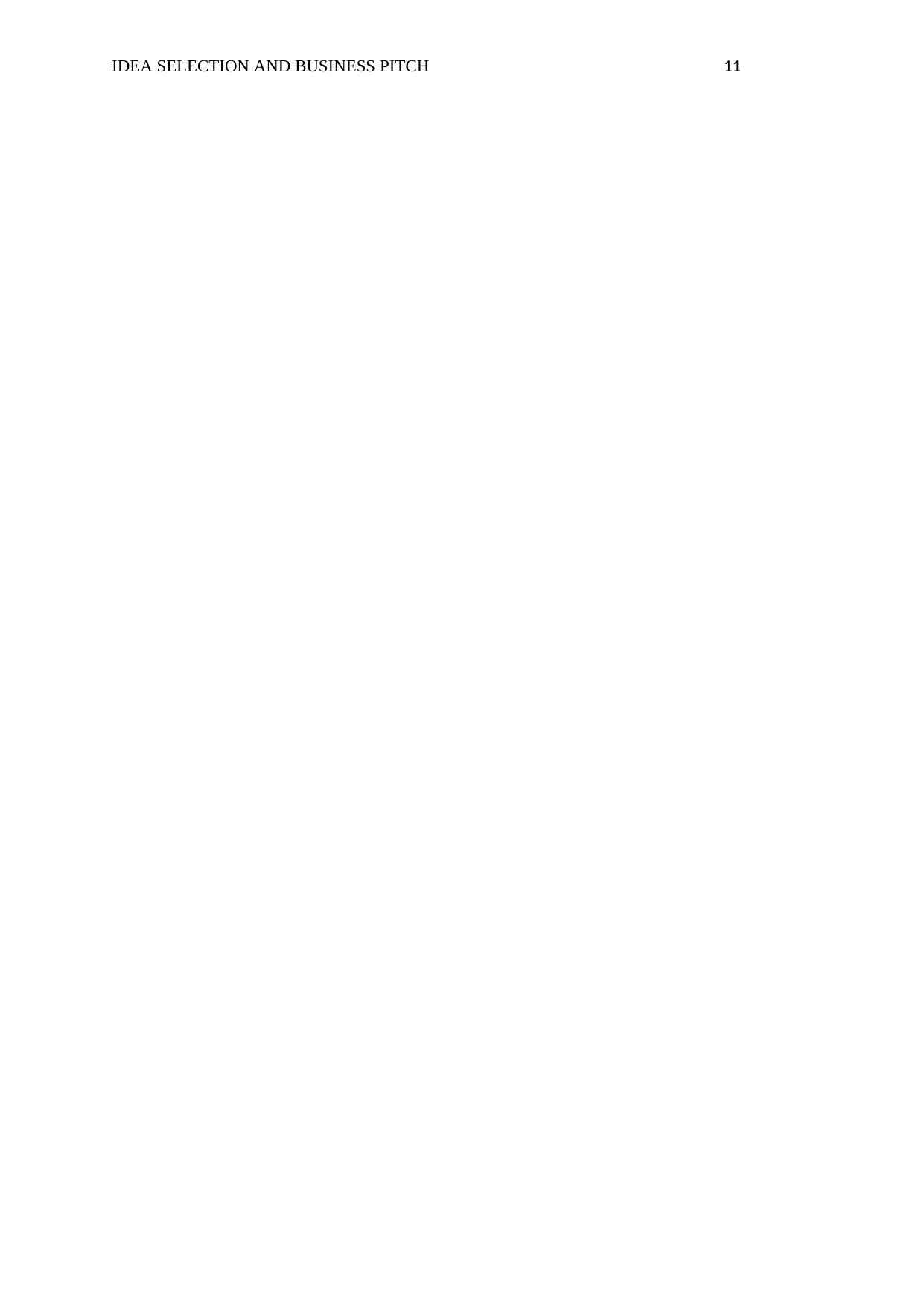
IDEA SELECTION AND BUSINESS PITCH 11
1 out of 11
Related Documents
Your All-in-One AI-Powered Toolkit for Academic Success.
+13062052269
info@desklib.com
Available 24*7 on WhatsApp / Email
![[object Object]](/_next/static/media/star-bottom.7253800d.svg)
Unlock your academic potential
© 2024 | Zucol Services PVT LTD | All rights reserved.





